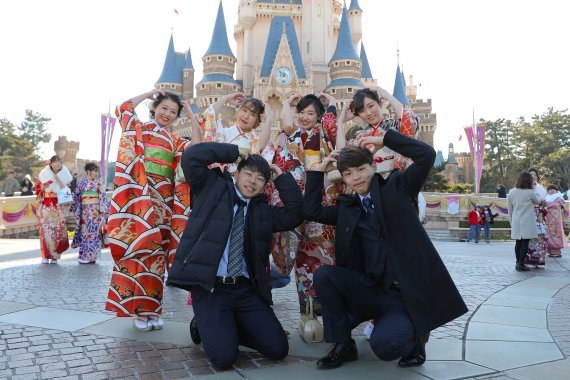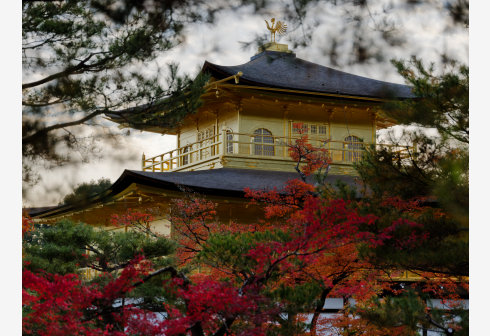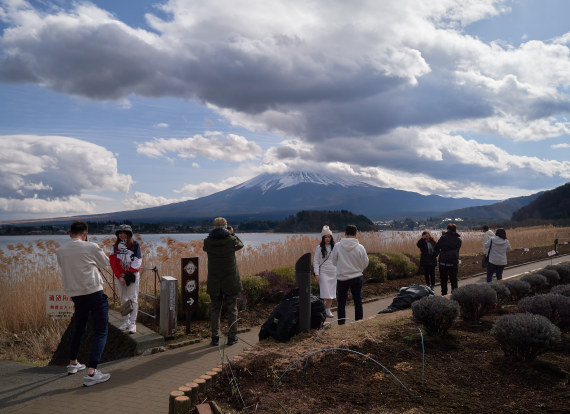In addition to breaking the record of the highest number of visitors to Japan set in 2019 by 2025 (31.88 million), Japan also needs to diversify its focus on attracting tourists from large cities to local areas.
Recently, Japan has once again become one of the popular destinations for overseas tourism.
In Japan, the 10 day short and long holiday from the end of April to the beginning of May witnessed the rising enthusiasm of overseas and local tourists: popular attractions such as Nihonbashi, Osaka City Park, Universal Studios are crowded, and railway and land travel also set new records in 2019. According to data from multiple tourism platforms in China, Japan has become the preferred destination for Chinese tourists to leave during the May Day holiday.
Although the Japan National Tourism Organization (JNTO) has not yet released its report on the travel and consumption of tourists during this year’s Golden Week in Japan, data from March shows that the number of foreign tourists entering Japan reached about 3.08 million, surpassing 3 million for the first time in a single month, an increase of 69.5% compared to the same period last year. Meanwhile, the total tourism consumption of tourists visiting Japan in the first quarter of this year reached 175.05 billion yen (approximately RMB 81.9 billion), setting a new historical high for a single season.
 (‘At Tokyo Disneyland in Chiba Prefecture, Japan, young people dressed in formal attire take photos in front of the castle. Information from Xinhua News Agency’,)
(‘At Tokyo Disneyland in Chiba Prefecture, Japan, young people dressed in formal attire take photos in front of the castle. Information from Xinhua News Agency’,)
The recent decline of the Japanese yen in the foreign exchange market is undoubtedly a great advantage for foreign tourists, because under the same budget, there are obviously more attractions and things to buy than before, and Japan’s catering, shopping, and accommodation related industries have become a reliable winner during the peak tourism season. Public data shows that since 2024, the Japanese yen has depreciated by over 8% against the US dollar. Especially in late April, the exchange rate of the Japanese yen against the US dollar rapidly declined, falling below 160 yen per dollar at one point, reaching a new low since April 1990. As of the time of publication by First Financial, under the influence of “mysterious funds”, the exchange rate of the Japanese yen to the US dollar has slightly rebounded to 155 yen to 1 US dollar.
The preliminary international balance of payments report released by the Japanese Ministry of Finance on the 10th shows that Japan’s trade balance has significantly improved in the fiscal year 2023 (April 2023 to March 2024), with a current account surplus reaching a historic high. In terms of service trade, benefiting from the increase in inbound tourism revenue, the service trade deficit narrowed to 2.45 trillion yen.
So, is the current popularity of inbound tourism in Japan solely due to exchange rate factors?
High value-added tourism as a keyword
According to Keiichi Kawamoto, Deputy General Manager of the Japan Travel Association’s (JATA) inbound tourism promotion department, exchange rate fluctuations are indeed the main factor currently favorable for Japan’s inbound tourism, but not limited to this. “The smooth hosting of the 2021 Tokyo Olympics and Paralympics, as well as the 2023 G7 Hiroshima Summit, have all made the international community more interested in Japanese tourism.”. Of course, Kawamoto also emphasized that the recovery of international flights after the epidemic, the warming of Japan South Korea relations, and the emergence of “retaliatory” consumption have all contributed to the current popularity of inbound tourism in Japan. “In short, this is composed of many factors.”.
The Japan Travel Industry Association, which has more than 1100 members of travel agencies in Japan, is also very concerned about the current trend of popular inbound tourism. In response to this phenomenon, an investigation has been conducted on Japanese tourism related enterprises. The latest survey results show that compared to before, tourists are currently most interested in “high value added travel”. “The number of tourists looking for unique travel experiences in Japan is increasing, such as staying overnight in temples, making sushi by hand, and trying pottery.”
Honda Shimin, director of the Overseas Attraction First Group of the Niigata Prefecture International Tourism Promotion Course, also agrees with this point. He told First Financial News, “Unlike checking in to popular cities before, choosing to visit niche cities and experience unique experiences and scenery in Japan is gradually becoming a focus of attention. Tourists’ choices of destinations are showing a diversified trend.”
He explained that currently, tourists are increasingly inclined to avoid crowded tourist destinations and prefer smaller and more private modes of travel; Moreover, with the diversification of travel destinations, there is a tendency towards customized travel, and high value-added special experiences are also favored. “People are more pursuing travel quality than travel frequency.”.
Indeed, during the Golden Week of May Day, with overseas tourists flocking to Japan, many social media platforms have seen friendly reminders to “discourage” popular attractions and switch to niche destinations.

According to Qunar data, during this golden week, Chinese tourists covered 212 relatively niche destinations in Japan, including Otaru, Tottori, and Saitama.
According to information released by Japan’s largest online booking website, Lotte Travel, during the Golden Week period, the most popular destinations for Japanese (domestic) tourists are not Tokyo or Osaka, but Fukui Prefecture, Nagasaki Prefecture, Nara Prefecture, Ibaraki Prefecture, and Hiroshima Prefecture, ranking in the top five.
Niigata Prefecture, where Honda Shimei is located, is also relatively niche compared to Tokyo, Osaka, and Kyoto. Honda Shimin told First Financial that Sado Island in Niigata Prefecture has unique traditional cultural characteristics, and there are many fun activities on the island that can only be experienced locally, such as hotels that enjoy spectacular and stunning sea views, and the “wooden boat” that is said to be the inspiration for the movie “Spirited Away”. He believes that with the popularity of inbound tourism, Niigata Prefecture can also benefit from it and become a popular tourist destination this year.
Explore ways to alleviate “excessive tourism”
The popularity of inbound tourism has indeed driven the upstream and downstream industries related to Japan’s tourism industry, and has also brought more niche cities into the view of tourists.
According to data from the Japan Department Store Association, the total sales of department stores nationwide in Japan reached 510.9 billion yen in March this year, marking the 25th consecutive month of growth. The duty-free sales of tourists visiting Japan increased by 2.5 times, reaching 49.5 billion yen, the highest value since the start of the survey in October 2014, and breaking records for three consecutive months. The sales revenue of tax-free goods in 2023 was 348.4 billion yen, about three times that of the previous year, setting a new high since 2015 with full year data. The high willingness to travel has also led to a continuous increase in hotel accommodation prices in Japan during the recently concluded May Day Golden Week.
However, while Japan’s tourism industry is improving, it is not without troubles. At present, a popular check-in point in Fuji Kawaguchi Lake Town, Yamanashi Prefecture, Japan has chosen to build a “wall” to prevent the influx of tourists from taking photos of Mount Fuji here.
 (‘Tourists admire Mount Fuji by the shores of Kawaguchi Lake in Yamanashi Prefecture, Japan. Xinhua News Agency Information Map’,)
(‘Tourists admire Mount Fuji by the shores of Kawaguchi Lake in Yamanashi Prefecture, Japan. Xinhua News Agency Information Map’,)
A local official told the media that some tourists who checked in here littered, some ignored traffic rules for taking photos, and building a blocking network was really forced and helpless. The shielding net is 2.5 meters high and 20 meters wide, used to cover Mount Fuji; If the situation improves in the future, it may be demolished. Hekou Lake Town is still a relatively less popular tourist attraction.
In the ancient city of Kamakura, which attracts 20 million visitors annually, there is a popular “Slam Dunk Master” among anime fans at the intersection. However, it is precisely because there are too many tourists taking photos that this intersection has become one of the most dangerous places in Kamakura, spreading onto the road.
Behind the troubles of Japan’s tourism industry mentioned above is the emerging problem of “over tourism” in recent years. It is worth noting that “excessive tourism” does not point all problems at tourists, but rather focuses on how to coordinate excessive tourism activities with local life.
The Japan Travel Association has not denied the situation of “excessive tourism”. Kawamoto told First Financial that the association has regarded this issue as a “priority solution” and will alleviate this problem through a package of policies launched by the Japanese government in October last year, such as promoting tourism etiquette and norms, encouraging tourists to experience rural areas, and encouraging the dispersion of holidays.
At the end of March last year, the Japanese government revised the Basic Plan for Promoting Tourism as a Nation (2023-2025) after a six-year interval. In addition to setting a new record for the highest number of visitors to Japan (31.88 million people) set in 2019 by 2025, it was also mentioned that efforts should be made to disperse the focus on attracting tourists from large cities to local areas. While striving for a larger number of tourists, we should also focus on improving quality by integrating with local residents.
Professor Takahiro Satoshi from the School of Tourism at Seibu International University in Japan has stated that the problem of “excessive tourism” occurred around the world 10 years ago, but in reality, there is no specific cure. Only by using validated and effective methods and combining punches can we achieve a balance between residents and tourists as much as possible.
After the Golden Week, Kawamoto said that he was preparing for this summer’s inbound tourism featuring parent-child tourism
Looking ahead to the future, Japanese tourism industry insiders interviewed by First Financial all hope that the popularity of inbound tourism in Japan will continue when the exchange rate stabilizes in the future. Bank of Japan Governor Kazuo Ueda recently stated last week that if the yen’s trend has a significant impact on inflation, the central bank may take monetary policy action.
